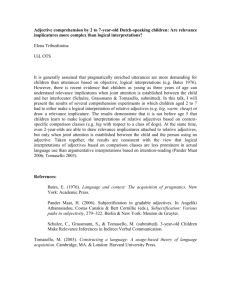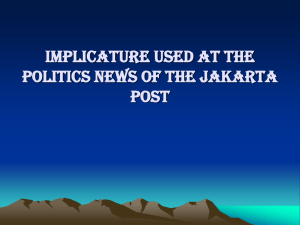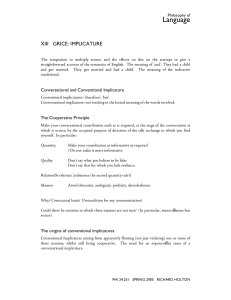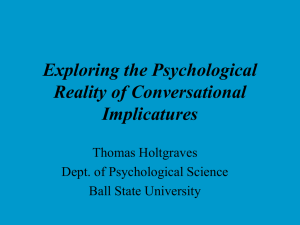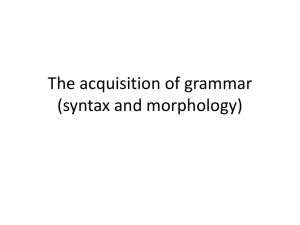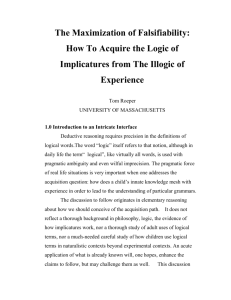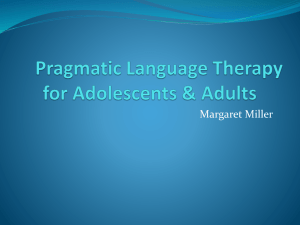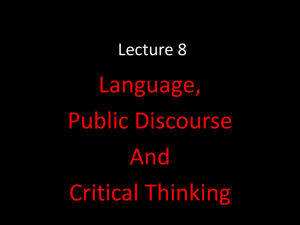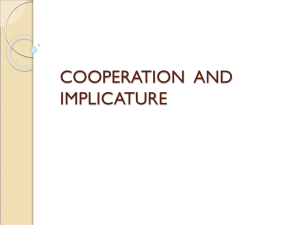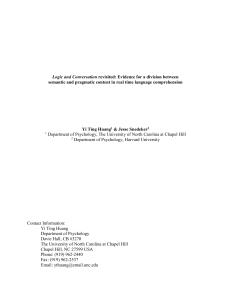abstract - Elspeth Wilson
advertisement
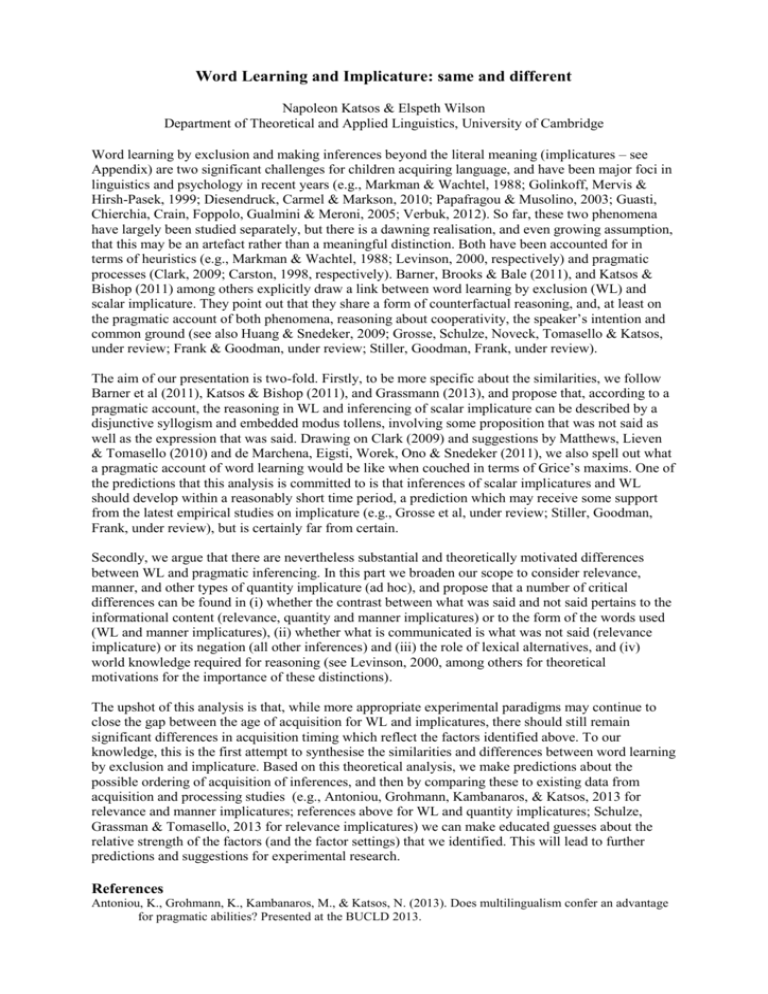
Word Learning and Implicature: same and different Napoleon Katsos & Elspeth Wilson Department of Theoretical and Applied Linguistics, University of Cambridge Word learning by exclusion and making inferences beyond the literal meaning (implicatures – see Appendix) are two significant challenges for children acquiring language, and have been major foci in linguistics and psychology in recent years (e.g., Markman & Wachtel, 1988; Golinkoff, Mervis & Hirsh-Pasek, 1999; Diesendruck, Carmel & Markson, 2010; Papafragou & Musolino, 2003; Guasti, Chierchia, Crain, Foppolo, Gualmini & Meroni, 2005; Verbuk, 2012). So far, these two phenomena have largely been studied separately, but there is a dawning realisation, and even growing assumption, that this may be an artefact rather than a meaningful distinction. Both have been accounted for in terms of heuristics (e.g., Markman & Wachtel, 1988; Levinson, 2000, respectively) and pragmatic processes (Clark, 2009; Carston, 1998, respectively). Barner, Brooks & Bale (2011), and Katsos & Bishop (2011) among others explicitly draw a link between word learning by exclusion (WL) and scalar implicature. They point out that they share a form of counterfactual reasoning, and, at least on the pragmatic account of both phenomena, reasoning about cooperativity, the speaker’s intention and common ground (see also Huang & Snedeker, 2009; Grosse, Schulze, Noveck, Tomasello & Katsos, under review; Frank & Goodman, under review; Stiller, Goodman, Frank, under review). The aim of our presentation is two-fold. Firstly, to be more specific about the similarities, we follow Barner et al (2011), Katsos & Bishop (2011), and Grassmann (2013), and propose that, according to a pragmatic account, the reasoning in WL and inferencing of scalar implicature can be described by a disjunctive syllogism and embedded modus tollens, involving some proposition that was not said as well as the expression that was said. Drawing on Clark (2009) and suggestions by Matthews, Lieven & Tomasello (2010) and de Marchena, Eigsti, Worek, Ono & Snedeker (2011), we also spell out what a pragmatic account of word learning would be like when couched in terms of Grice’s maxims. One of the predictions that this analysis is committed to is that inferences of scalar implicatures and WL should develop within a reasonably short time period, a prediction which may receive some support from the latest empirical studies on implicature (e.g., Grosse et al, under review; Stiller, Goodman, Frank, under review), but is certainly far from certain. Secondly, we argue that there are nevertheless substantial and theoretically motivated differences between WL and pragmatic inferencing. In this part we broaden our scope to consider relevance, manner, and other types of quantity implicature (ad hoc), and propose that a number of critical differences can be found in (i) whether the contrast between what was said and not said pertains to the informational content (relevance, quantity and manner implicatures) or to the form of the words used (WL and manner implicatures), (ii) whether what is communicated is what was not said (relevance implicature) or its negation (all other inferences) and (iii) the role of lexical alternatives, and (iv) world knowledge required for reasoning (see Levinson, 2000, among others for theoretical motivations for the importance of these distinctions). The upshot of this analysis is that, while more appropriate experimental paradigms may continue to close the gap between the age of acquisition for WL and implicatures, there should still remain significant differences in acquisition timing which reflect the factors identified above. To our knowledge, this is the first attempt to synthesise the similarities and differences between word learning by exclusion and implicature. Based on this theoretical analysis, we make predictions about the possible ordering of acquisition of inferences, and then by comparing these to existing data from acquisition and processing studies (e.g., Antoniou, Grohmann, Kambanaros, & Katsos, 2013 for relevance and manner implicatures; references above for WL and quantity implicatures; Schulze, Grassman & Tomasello, 2013 for relevance implicatures) we can make educated guesses about the relative strength of the factors (and the factor settings) that we identified. This will lead to further predictions and suggestions for experimental research. References Antoniou, K., Grohmann, K., Kambanaros, M., & Katsos, N. (2013). Does multilingualism confer an advantage for pragmatic abilities? Presented at the BUCLD 2013. Barner, D., Brooks, N., & Bale, A. (2011). Accessing the unsaid: The role of scalar alternatives in children’s pragmatic inference. Cognition, 118(1), 87–96. Carston, R. (1998). Informativeness, relevance and scalar implicature. In Carston, R., Uchida, S. (Eds.). Relevance Threory: Applications and Implications (pp.179-236). Amsterdam John Benjamins. Clark, E. V. (2009). First language acquisition. Cambridge University Press. De Marchena, A., Eigsti, I. M., Worek, A., Ono, K. E., & Snedeker, J. (2011). Mutual exclusivity in autism spectrum disorders: Testing the pragmatic hypothesis. Cognition, 119(1), 96–113. Diesendruck, G., Carmel, N., & Markson, L. (2010). Children’s sensitivity to the conventionality of sources. Child Development, 81(2), 652–668. Frank, M. C., & Goodman, N. D. (under review). Inferring word meanings by assuming that speakers are informative. Golinkoff, R., Hirsh-Pasek, K., & Hollich, G. (1999). Emerging cues for early word learning. In B. MacWhinney (Ed.), The emergence of language (pp. 305–329). Lawrence Erlbaum Associates, Inc. Mahwah, NJ. Grassmann, S. (2013). Word learning by exclusion-pragmatics, logic and processing. Beyond Words: Content, Context, and Inference, 15, 67–89. Grice, H. P. (1975). Logic and conversation. In R. Stainton (Ed.), Perspectives in the Philosophy of Language (pp. 41–58). Broadview Press. Grosse, G., Schulze, C., Noveck, I., Tomasello, M., & Katsos, N. (under review). Three-year-olds make some, but not all inferences based on informativeness. Guasti, M. T., Chierchia, G., Crain, S., Foppolo, F., Gualmini, A., & Meroni, L. (2005). Why children and adults sometimes (but not always) compute implicatures. Language and Cognitive Processes, 20(5), 667–696. Huang, Y. T., & Snedeker, J. (2009). Semantic Meaning and Pragmatic Interpretation in 5-Year-Olds: Evidence From Real-Time Spoken Language Comprehension. Developmental Psychology, 45(6), 1723–1739. Katsos, N., & Bishop, D. V. (2011). Pragmatic tolerance: Implications for the acquisition of informativeness and implicature. Cognition, 120(1), 67–81. Levinson, S. C. (2000). Presumptive meanings: The theory of generalized conversational implicature. MIT Press. Markman, E. M., & Wachtel, G. F. (1988). Children’s use of mutual exclusivity to constrain the meanings of words. Cognitive Psychology, 20(2), 121–157. Matthews, D., Lieven, E., & Tomasello, M. (2007). How toddlers and preschoolers learn to uniquely identify referents for others: A training study. Child Development, 78(6), 1744–1759. Papafragou, A., & Musolino, J. (2003). Scalar implicatures: Experiments at the semantics-pragmatics interface. Cognition, 86(3), 253–282. Schulze, C. (2013). Relevance inferences in young children: 3-year-olds’ understand a speaker’s indirectly expressed social intention. Beyond Words: Content, Context, and Inference, 15, 109. Stiller, A. J., Goodman, N. D., & Frank, M. C. (under review). Ad-hoc Implicatures in Preschool Children. Verbuk, A. (2012). Developmental evidence against the theoretical distinction between Horn and pragmatic scales. Journal of Pragmatics, 44(12), 1680–1700. Appendix Consider (1) and (2): (1) [Jane and her child are looking at a parrot and a jay in a picture-book. The toddler knows the word for parrot, but not for jay] Jane: Look, a jay! (2) Child: Will my friends be at the party? Jane: Some of them will. In the example of word learning by exclusion in (1), the child should learn that “jay” is the name for the unfamiliar bird, rather than assume it is another label for a parrot or a more general category term like “bird”. In general terms, this involves reasoning to the effect that if Jane meant to refer to the known bird, parrot, she would have used the known word, “parrot”. In the implicature case in (2), the child should infer that not all of her friends will be at the party. Again in general terms, this involves reasoning to the effect that if Jane knew that all the child’s friends would be there, she would have said so.

